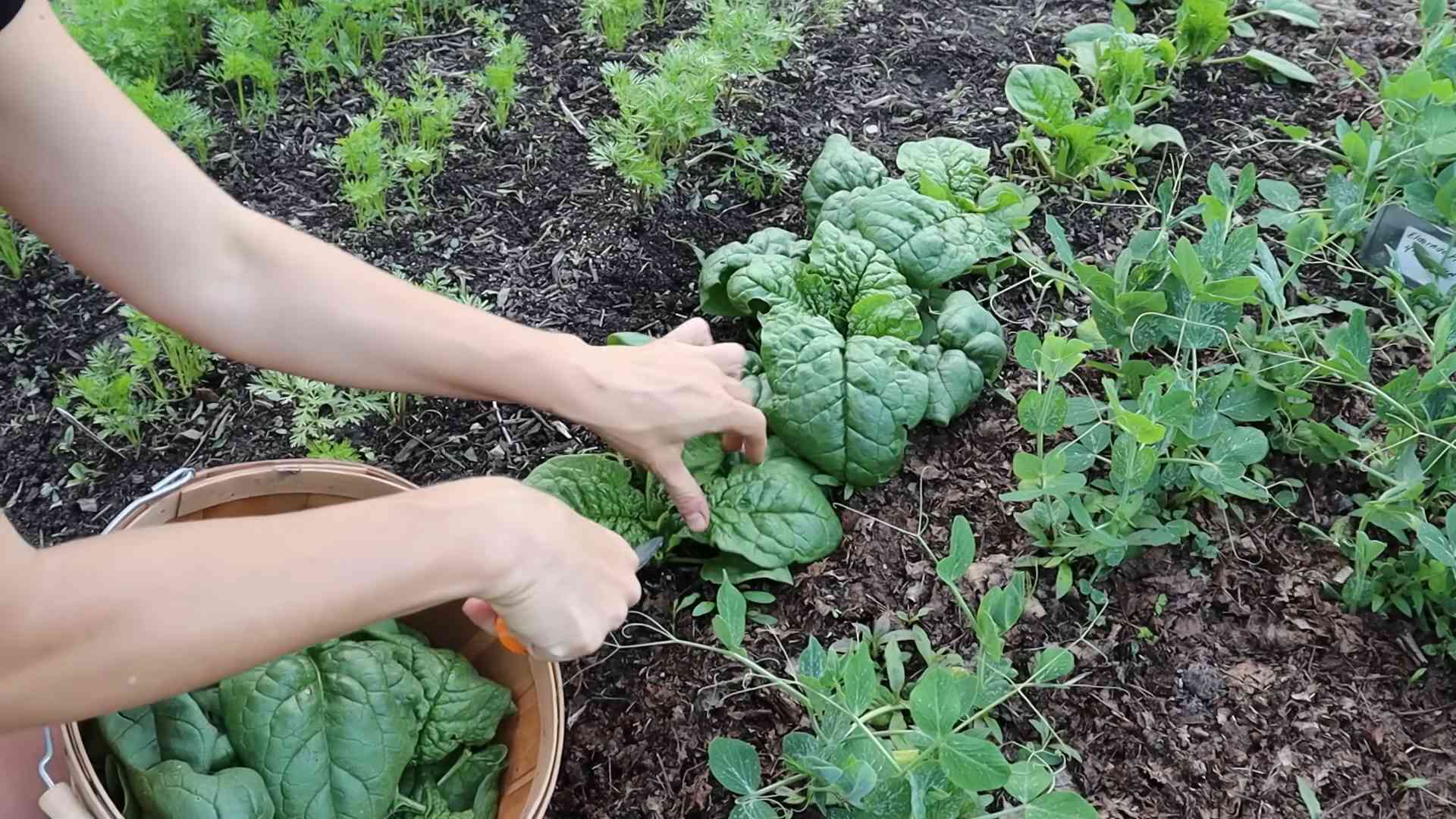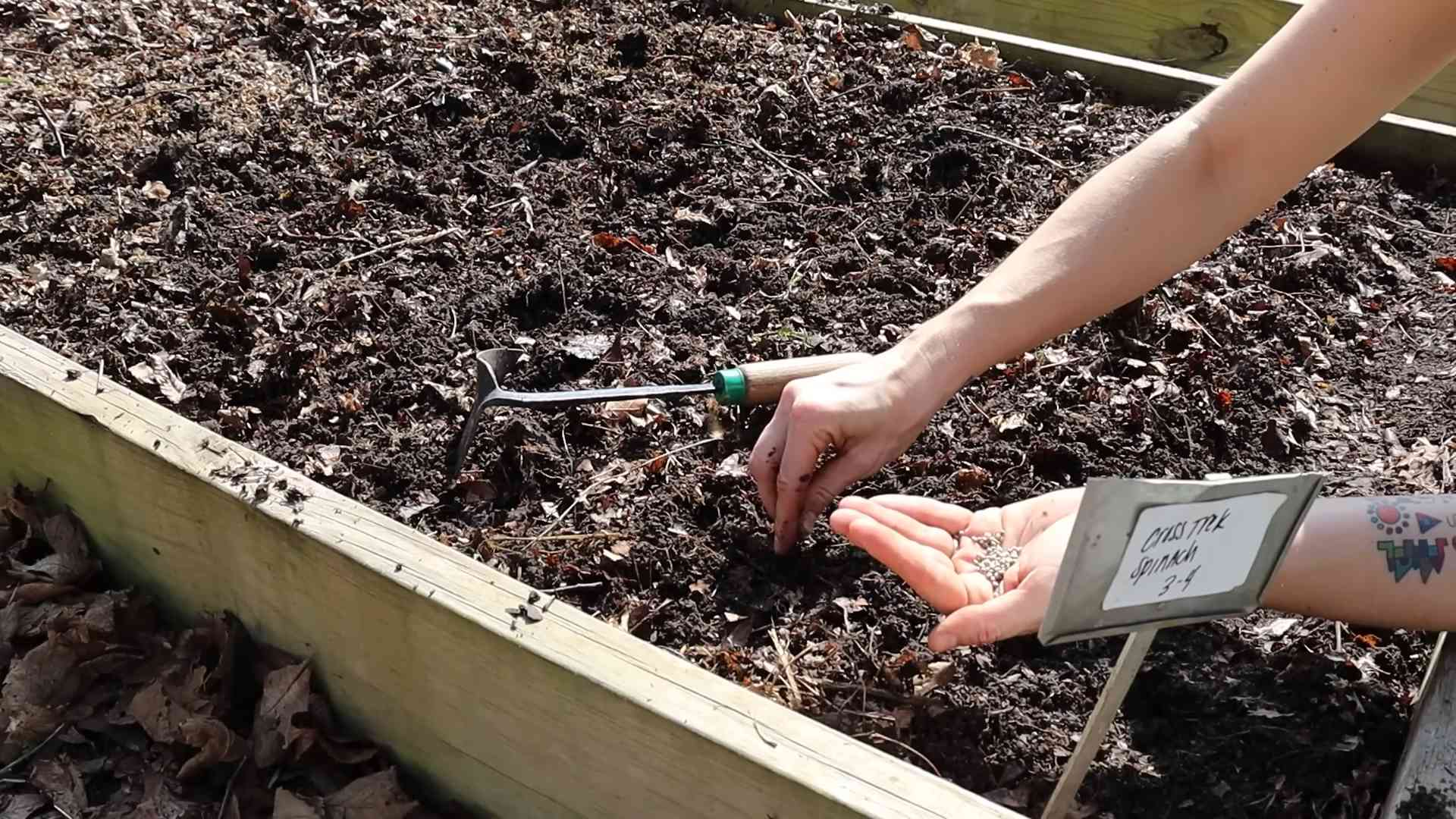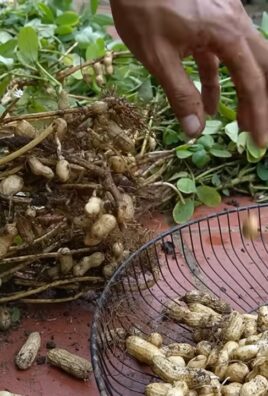Grow Spinach at Home and unlock a world of fresh, nutritious greens right at your fingertips! Imagine stepping into your backyard or even just onto your balcony and harvesting vibrant, leafy spinach for your salads, smoothies, or sautés. No more trips to the grocery store, no more wilted, pre-packaged greens – just pure, homegrown goodness.
For centuries, spinach has been a staple in diets around the globe, prized for its incredible health benefits and versatility in the kitchen. From ancient Persia, where it’s believed to have originated, to its adoption into European cuisine during the Middle Ages, spinach has nourished generations. But did you know that growing your own spinach is surprisingly easy and rewarding?
In today’s fast-paced world, knowing how to grow spinach at home offers a welcome escape and a connection to nature. It’s a chance to slow down, get your hands dirty, and witness the magic of life unfolding. Plus, with rising food costs and concerns about pesticides, cultivating your own spinach ensures you’re getting the freshest, healthiest produce possible. I’m excited to share some simple DIY tricks and hacks that will have you harvesting your own spinach in no time, even if you have limited space or gardening experience. Let’s get started!

Grow Your Own Spinach: A Beginner’s Guide to a Bountiful Harvest
Hey there, fellow gardening enthusiasts! I’m so excited to share my experience with growing spinach at home. It’s surprisingly easy, super rewarding, and nothing beats the taste of fresh, homegrown spinach in your salads, smoothies, or cooked dishes. Let’s dive in!
Choosing Your Spinach Variety
Before we get our hands dirty, let’s talk spinach varieties. There are a few main types, and choosing the right one for your climate and preferences is key.
* Savoy: This type has crinkled, curly leaves. It’s cold-hardy and great for fall and winter crops. Examples include ‘Bloomsdale’ and ‘Melody’.
* Semi-Savoy: A good compromise, with slightly crinkled leaves that are easier to clean than Savoy types. ‘Tyee’ is a popular choice.
* Smooth-Leaf: These have flat, smooth leaves, making them the easiest to clean. They’re often preferred for processing and canning. ‘Space’ and ‘Giant Nobel’ are good options.
* Baby Leaf: These varieties are specifically bred for harvesting at a young stage, perfect for salads.
I personally love growing ‘Bloomsdale’ for its robust flavor and cold hardiness, and ‘Space’ for its smooth leaves and ease of use. Consider your climate and what you plan to do with your spinach when making your choice.
Getting Started: Seeds vs. Seedlings
You have two options when starting your spinach journey: seeds or seedlings.
* Seeds: Starting from seed is generally more economical and gives you a wider variety of choices. Spinach seeds germinate best in cool soil.
* Seedlings: Buying seedlings gives you a head start, especially if you’re late in the season or want a quicker harvest.
I usually start from seed because I enjoy the process and it’s easier to find the specific varieties I want. However, if you’re short on time or space, seedlings are a great option.
Preparing Your Planting Area
Spinach thrives in well-drained soil that’s rich in organic matter. Here’s how to prepare your planting area:
* Location: Choose a spot that gets at least 4-6 hours of sunlight per day. Spinach can tolerate some shade, especially in hotter climates.
* Soil: Spinach prefers a soil pH between 6.5 and 7.0. Amend your soil with compost or well-rotted manure to improve drainage and fertility.
* Clear the Area: Remove any weeds, rocks, or debris from the planting area.
* Loosen the Soil: Use a garden fork or tiller to loosen the soil to a depth of at least 6 inches.
I like to add a generous layer of compost to my spinach bed before planting. It really helps with moisture retention and provides essential nutrients.
Planting Your Spinach
Now for the fun part! Here’s how to plant your spinach, whether you’re starting from seed or seedlings:
Planting from Seed
1. Sow Seeds: Sow seeds about 1/2 inch deep and 1 inch apart in rows that are 12-18 inches apart.
2. Water Gently: Water the soil gently after planting to avoid disturbing the seeds.
3. Keep Moist: Keep the soil consistently moist until the seeds germinate, which usually takes 5-10 days.
4. Thin Seedlings: Once the seedlings emerge, thin them to about 3-6 inches apart. This will give them enough room to grow.
Planting Seedlings
1. Dig Holes: Dig holes that are slightly larger than the root ball of the seedlings. Space the holes 3-6 inches apart.
2. Remove Seedlings: Gently remove the seedlings from their containers.
3. Place Seedlings: Place the seedlings in the holes, making sure the top of the root ball is level with the soil surface.
4. Fill Holes: Fill the holes with soil and gently firm around the base of the seedlings.
5. Water Thoroughly: Water the seedlings thoroughly after planting.
I find that planting in succession, sowing a new batch of seeds every 2-3 weeks, ensures a continuous harvest throughout the growing season.
Caring for Your Spinach Plants
Once your spinach is planted, it’s important to provide proper care to ensure a healthy and abundant harvest.
* Watering: Spinach needs consistent moisture, especially during hot weather. Water deeply whenever the top inch of soil feels dry. Avoid overhead watering, as this can promote fungal diseases.
* Fertilizing: Spinach is a heavy feeder, so it benefits from regular fertilization. Use a balanced fertilizer or side-dress with compost every few weeks.
* Weeding: Keep the planting area free of weeds, as they can compete with spinach for nutrients and water.
* Pest Control: Keep an eye out for pests like aphids, leaf miners, and flea beetles. Use organic pest control methods, such as insecticidal soap or neem oil, to control infestations.
* Bolting Prevention: Bolting (when the plant sends up a flower stalk) is a common problem with spinach, especially in hot weather. To prevent bolting, choose bolt-resistant varieties, provide shade during the hottest part of the day, and harvest regularly.
I like to use a soaker hose to water my spinach plants. It delivers water directly to the roots, minimizing water waste and reducing the risk of fungal diseases.
Harvesting Your Spinach
The best part! You can start harvesting spinach leaves as soon as they are large enough to eat, usually about 4-6 weeks after planting.
* Harvesting Method: You can harvest individual leaves or cut the entire plant at the base.
* Harvesting Time: Harvest spinach in the morning, when the leaves are crisp and cool.
* Regular Harvesting: Regular harvesting encourages the plant to produce more leaves.
* Bolting Signs: If you notice signs of bolting (a tall flower stalk emerging from the center of the plant), harvest the entire plant immediately. The leaves will become bitter once the plant bolts.
I usually harvest the outer leaves first, allowing the inner leaves to continue growing. This extends the harvest period.
Dealing with Common Spinach Problems
Even with the best care, you might encounter some problems when growing spinach. Here are a few common issues and how to address them:
* Aphids: These tiny insects can suck the sap from spinach leaves, causing them to become distorted and yellow. Spray aphids with insecticidal soap or neem oil.
* Leaf Miners: These pests tunnel inside spinach leaves, leaving unsightly trails. Remove and destroy infested leaves. You can also use row covers to prevent leaf miners from laying eggs on your plants.
* Downy Mildew: This fungal disease causes yellow spots on the upper surface of spinach leaves and a gray, fuzzy growth on the underside. Choose downy mildew-resistant varieties and avoid overhead watering.
* Bolting: As mentioned earlier, bolting is a common problem in hot weather. Choose bolt-resistant varieties, provide shade, and harvest regularly.
I always try to address problems as soon as I notice them. Early detection and treatment can prevent minor issues from becoming major headaches.
Extending Your Spinach Season
Spinach is a cool-season crop, but you can extend your growing season with a few simple techniques:
* Succession Planting: Sow seeds every 2-3 weeks to ensure a continuous harvest.
* Cold Frames: Use cold frames or row covers to protect spinach plants from frost and extend the growing season into the fall and winter.
* Shade Cloth: Use shade cloth to protect spinach plants from the intense heat of summer.
* Overwintering: In mild climates, you can overwinter spinach plants by providing them with protection from the cold.
I love growing spinach throughout the winter in my cold frame. It’s such a treat to have fresh greens available even when the weather is cold and dreary.
Enjoying Your Harvest
Now that you’ve successfully grown your own spinach, it’s time to enjoy the fruits (or rather, leaves!) of your labor.
* Fresh: Spinach is delicious fresh in salads, smoothies, and sandwiches.
* Cooked: Spinach can be steamed, sautéed, or added to soups, stews, and casseroles.
* Frozen: If you have a surplus of spinach, you can freeze it for later use. Blanch the spinach leaves for a few minutes before freezing to preserve their color and flavor.
I love adding fresh spinach to my morning smoothies. It’s a great way to get a boost of vitamins and minerals. I also enjoy sautéing spinach with garlic and olive oil as a simple and healthy side dish.
Growing spinach at home is a rewarding experience that anyone can enjoy. With a little planning and care, you can have a bountiful harvest of fresh, delicious spinach all season long.

Conclusion
So, there you have it! Growing spinach at home is not only achievable, but it’s also incredibly rewarding. Forget those limp, pre-packaged greens from the supermarket. Imagine stepping into your garden or onto your balcony and harvesting vibrant, crisp spinach leaves bursting with flavor and nutrients. This DIY approach puts you in control, allowing you to cultivate the freshest, most delicious spinach imaginable.
Why is this a must-try? Because it’s more than just growing a vegetable; it’s about connecting with your food, reducing your carbon footprint, and enjoying the unparalleled taste of homegrown produce. You’ll know exactly what went into your spinach – no pesticides, no questionable additives, just pure, natural goodness. Plus, it’s a fantastic way to get some fresh air and sunshine, even if you only have a small space.
But the beauty of growing spinach at home lies in its adaptability. Feel free to experiment! Try different varieties of spinach, such as baby spinach for tender salads or savoy spinach for cooking. Consider companion planting – spinach thrives alongside other cool-season crops like radishes, lettuce, and strawberries. You can also adjust the planting schedule to extend your harvest season. Succession planting, where you sow new seeds every few weeks, ensures a continuous supply of fresh spinach throughout the cooler months.
Don’t be afraid to get creative with your growing methods. If you’re short on space, vertical gardening or container gardening are excellent options. You can even grow spinach indoors under grow lights, providing a year-round supply of this nutritious leafy green.
The possibilities are endless, and the rewards are immense. We wholeheartedly encourage you to give this DIY trick a try. It’s easier than you might think, and the satisfaction of harvesting your own spinach is truly unparalleled.
Ready to ditch the store-bought spinach and embrace the joy of homegrown goodness? We’re confident that you’ll be amazed by the results.
And most importantly, we want to hear about your experience! Share your tips, tricks, and triumphs in the comments below. Let us know what worked for you, what challenges you faced, and any variations you tried. Together, we can create a community of home gardeners who are passionate about growing their own food and enjoying the many benefits of fresh, homegrown spinach. So, grab your seeds, get your hands dirty, and start growing spinach at home today! You won’t regret it.
Frequently Asked Questions (FAQ)
What is the best time of year to plant spinach?
Spinach is a cool-season crop, meaning it thrives in cooler temperatures. The best time to plant spinach is in early spring or early fall. For a spring crop, sow seeds as soon as the ground can be worked, typically 4-6 weeks before the last expected frost. For a fall crop, plant seeds 6-8 weeks before the first expected frost. In warmer climates, you can grow spinach throughout the winter. Avoid planting spinach during the heat of summer, as high temperatures can cause it to bolt (go to seed) and become bitter.
What kind of soil does spinach need?
Spinach prefers well-drained soil that is rich in organic matter. The ideal soil pH is between 6.5 and 7.0. Before planting, amend the soil with compost or well-rotted manure to improve its fertility and drainage. If your soil is heavy clay, consider adding sand or other amendments to improve drainage. Spinach also benefits from a soil that retains moisture, so mulching around the plants can help to keep the soil consistently moist.
How much sunlight does spinach need?
Spinach needs at least 3-6 hours of sunlight per day. While it can tolerate some shade, especially in warmer climates, it will grow best in a sunny location. If you are growing spinach indoors, you will need to provide supplemental lighting, such as grow lights, to ensure that it receives enough light.
How often should I water spinach?
Spinach needs consistent moisture to thrive. Water regularly, especially during dry periods, to keep the soil consistently moist but not waterlogged. Avoid overhead watering, as this can promote fungal diseases. Instead, water at the base of the plants. A good rule of thumb is to water when the top inch of soil feels dry to the touch.
How do I fertilize spinach?
Spinach is a heavy feeder, so it benefits from regular fertilization. Before planting, incorporate a balanced fertilizer into the soil. During the growing season, fertilize every 2-3 weeks with a nitrogen-rich fertilizer, such as fish emulsion or compost tea. Avoid over-fertilizing, as this can cause the spinach to accumulate nitrates.
How do I harvest spinach?
You can begin harvesting spinach leaves as soon as they are large enough to eat, typically about 4-6 weeks after planting. Harvest the outer leaves first, leaving the inner leaves to continue growing. You can either cut the leaves with scissors or gently snap them off by hand. To extend the harvest season, avoid harvesting more than one-third of the plant at a time.
What are some common pests and diseases that affect spinach?
Spinach is susceptible to several pests and diseases, including aphids, leaf miners, flea beetles, and downy mildew. To prevent pest and disease problems, practice good garden hygiene, such as removing weeds and debris from around the plants. You can also use insecticidal soap or neem oil to control pests. To prevent downy mildew, choose disease-resistant varieties and avoid overhead watering.
Can I grow spinach in containers?
Yes, spinach grows well in containers. Choose a container that is at least 6 inches deep and has drainage holes. Fill the container with a well-draining potting mix. Plant the spinach seeds or seedlings according to the instructions on the seed packet or plant label. Water regularly and fertilize as needed.
How do I prevent spinach from bolting?
Bolting is when spinach prematurely goes to seed, which can make the leaves bitter. To prevent bolting, plant spinach in early spring or early fall, when temperatures are cooler. Choose bolt-resistant varieties. Provide shade during the hottest part of the day. Water regularly to keep the soil consistently moist. Harvest the leaves regularly to encourage continued growth.
How do I store harvested spinach?
To store harvested spinach, wash the leaves thoroughly and dry them with a salad spinner or paper towels. Store the spinach in a plastic bag or container in the refrigerator. It will keep for up to a week. You can also freeze spinach for longer storage. To freeze spinach, blanch the leaves in boiling water for 2 minutes, then plunge them into ice water. Drain the spinach and squeeze out any excess water. Pack the spinach into freezer bags or containers and freeze.
What are some creative ways to use my homegrown spinach?
Beyond salads, homegrown spinach is incredibly versatile! Sauté it with garlic and olive oil for a simple side dish. Add it to smoothies for a nutritional boost. Use it in quiches, frittatas, or omelets. Incorporate it into pasta dishes or soups. You can even use it to make spinach pesto or spinach dip. The possibilities are endless!





Leave a Comment